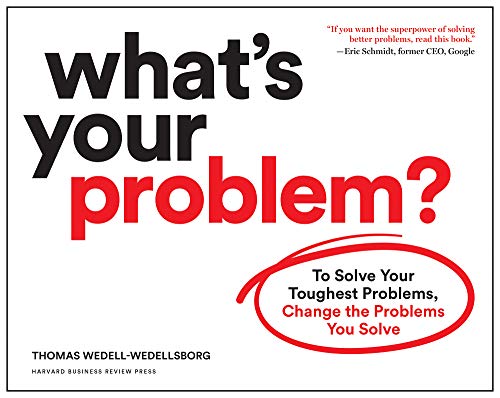Overview of What’s Your Problem?: To Solve Your Toughest Problems, Change the Problems You Solve by Thomas Wedell-Wedellsborg Link to heading
Summary Link to heading
What’s Your Problem? by Thomas Wedell-Wedellsborg is a book that focuses on problem-solving by reframing the way problems are approached. The author introduces the concept of “reframing” as a method to uncover the real issues behind problems, advocating for a shift in perspective to generate innovative solutions. Through a combination of real-world examples and practical guidance, the book provides a step-by-step framework to break down and understand complex problems, ultimately leading to more effective problem-solving strategies.
Review Link to heading
Thomas Wedell-Wedellsborg presents an engaging and insightful guide to improving problem-solving skills by redefining the problems themselves. The book’s strength lies in its relatable examples and clear framework, making it accessible to both individuals and organizations looking to enhance their strategic thinking. A notable critique could be that it requires readers to actively apply the reframing techniques to fully grasp their value, which might require sustained effort. Overall, the book successfully empowers readers to rethink traditional approaches to problem-solving.
Key Takeaways Link to heading
- Reframe Problems: Instead of tackling the first apparent problem, take time to reevaluate and redefine it to uncover underlying issues.
- Ask Better Questions: Sharpen your questioning skills to gain deeper insights into the problem at hand.
- Challenge Assumptions: Regularly question and test assumptions to avoid blind spots in problem-solving.
- Collaborative Reframing: Engage with a diverse group to get different perspectives, which can lead to better problem definitions.
- Iterative Approach: Allow the problem-solving process to be flexible and iterative, adjusting as more is learned about the problem.
Recommendation Link to heading
What’s Your Problem? is highly recommended for anyone involved in decision-making processes, from business leaders to educators, who are seeking to enhance their strategic problem-solving capabilities. The book’s practical approach is particularly beneficial for those looking to cultivate a culture of innovation and critical thinking within their organizations.
